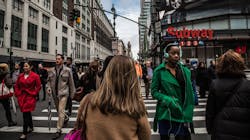Redfin ranks most walkable cities in North America
Real estate firm Redfin has released its top cities in the United States and Canada with the highest walkability for 2020 using a measure its calls the Walk Score®.
In the U.S., New York City, San Francisco, Boston, Philadelphia and Miami were the top walkable cities, while Vancouver, Montreal, Toronto, Burnaby, B.C. and Longueuil, Quebec, topped the Canadian rankings. The population threshold for the ranking was set at above 300,000 residents for U.S. cities and 200,000 residents for Canadian cities.
In simple terms, the Walk Score measures how easy it is to run most errands without the use of a car. The higher the score, the easier it is to run these errands. According to Redfin, Walk Score analyzes hundreds of walking routes to nearby amenities with points awarded based on the distance to amenities in each category. The real estate site also assigns addresses a Transit Score and Bike Score.
Redfin Vancouver Market Manager Brooks Findlay explains that ease of movement among residents was a focus of development as Vancouver built during the past decade.
“Over the past 10 years, Vancouver has placed a strong emphasis on development that supports walkability. Many of the new developments are focused on areas that are close to transit—specifically our monorail system,” Findlay said. “The city itself has also been very focused on building new walking and bike paths, allowing for a green commute and discouraging single-driver vehicles. Many young professionals in Vancouver don’t even consider owning a car. Developers have created mini villages in high-traffic areas, meaning you don’t have to travel more than five or six blocks to get anything you need.”
San Francisco achieved its highest Walk Score, a development local Redfin agent Chris Dawe says has occurred over several years.
“The sheer number of people moving into San Francisco for jobs and the creation of infrastructure to accommodate them has created a ripple effect for walkability,” said Dawe. “I’ve lived here my entire life and I’ve seen the makeup of the city change from pockets of walkable neighborhoods joined by cars and public transit to one interconnected area. As housing prices have gone up and the more far-flung neighborhoods have become more popular, the city adds infrastructure, businesses move in and they become more walkable and more connected to other areas.”
Other notable Walk Score changes include Miami and Washington, D.C. each lost about 1.5 points, and New York lost almost one, but each retained its place in the rankings.
Oakland; Long Beach, Calif.; Portland, Ore. and Omaha, Neb., which each picked up around two points, had the biggest Walk Score increases since Redfin last released national rankings in 2017. On the opposite side of the spectrum, Baltimore, Md., saw the biggest Walk Score decline of any U.S. city with the loss of four points, followed by Bakersfield, Calif., and San Antonio, Texas which each dropped three points.
About the Author

Mischa Wanek-Libman
Group Editorial Director
Mischa Wanek-Libman is director of communications with Transdev North America. She has more than 20 years of experience working in the transportation industry covering construction projects, engineering challenges, transit and rail operations and best practices.
Wanek-Libman has held top editorial positions at freight rail and public transportation business-to-business publications including as editor-in-chief and editorial director of Mass Transit from 2018-2024. She has been recognized for editorial excellence through her individual work, as well as for collaborative content.
She is an active member of the American Public Transportation Association's Marketing and Communications Committee and served 14 years as a Board Observer on the National Railroad Construction and Maintenance Association (NRC) Board of Directors.
She is a graduate of Drake University in Des Moines, Iowa, where she earned a Bachelor of Arts degree in Journalism and Mass Communication.
